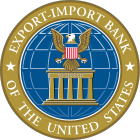Export–Import Bank of the United States
 |
|
| Agency overview | |
|---|---|
| Formed | February 2, 1934 |
| Headquarters |
Lafayette Building Washington, D.C. |
| Employees | 402 (2013) |
| Agency executive |
|
| Website | www.exim.gov |
The Export–Import Bank of the United States (abbreviated as Ex-Im Bank) is the official export credit agency of the United States federal government. Operating as a government corporation, the bank finances and insures foreign purchases of United States goods for customers unable or unwilling to accept credit risk. According to its charter, the Ex-Im Bank does not compete with private sector lenders, but rather provides financing for transactions that would otherwise not occur because commercial lenders are either unable or unwilling to accept the political or commercial risks inherent in the deal. Its current chairman and president is Fred Hochberg.
The bank was established in 1934 by an executive order, and made an independent agency in the Executive Branch by Congress in 1945. It was last chartered for a three-year term in 2012 and in September 2014 was extended through June 30, 2015. Congressional authorization for the bank lapsed as of July 1, 2015. As a result, the bank could not engage in new business, but it continued to manage its existing loan portfolio. Five months later, after the successful employment of the rarely used discharge petition procedure in the House of Representatives, the U.S. Congress reauthorized the bank until September 2019, by a section included in a major transportation funding bill, which was signed into law on December 4, 2015 by President Barack Obama.
The cost and effectiveness of the bank are controversial. While the Ex-Im Bank projects will earn the U.S. government an average of $1.4 billion per year for the next 10 years, an alternative analysis from the Congressional Budget Office found that the program would lose about $2 billion during the same period, partly due to discrepancies in how credit risk is accounted for. Both conservative and liberal groups have been critical of the bank, and some continue to demand its termination.
...
Wikipedia
